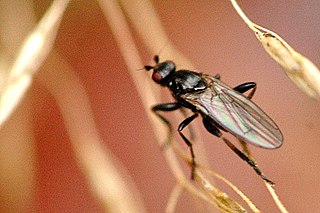
Sphaeroceridae are a family of true flies in the order Diptera, often called small dung flies, lesser dung flies or lesser corpse flies due to their saprophagous habits. They belong to the typical fly suborder Brachycera as can be seen by their short antennae, and more precisely they are members of the section Schizophora. There are over 1,300 species and about 125 genera accepted as valid today, but new taxa are still being described.

Carnoidea is a superfamily of Acalyptratae flies.

Carnidae, also known as bird flies or filth flies, is a family of flies (Diptera). There are 6 genera, containing about 93 species worldwide.

Clusiidae or "druid flies" is a family of small, thin, yellow to black acalyptrate flies with a characteristic antenna and with the wing usually partially infuscated. They have a cylindrical body. The head is round, the vertical plate reaches the anterior margin of the frons and the vibrissae on the head are large. The costa is interrupted near subcosta and the latter developed throughout length. Larvae are found in the bark of trees, the flies on trunks. The larvae are notable for their ability to jump. Males of many species in the subfamily Clusiodinae have been observed while engaged in lekking behaviour. There are hundreds of species in 14 genera found in all the Ecoregions, although most species occur in tropical regions. The type genus is Clusia Haliday, 1838.
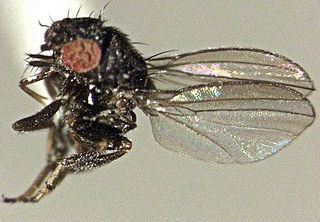
Milichiidae are a family of flies. Most species are very small and dark. Details of their biology have not yet been properly studied, but they are best known as kleptoparasites of predatory invertebrates, and accordingly are commonly known as freeloader flies or jackal flies. However, because of the conditions under which many species breed out, they also are known as filth flies.
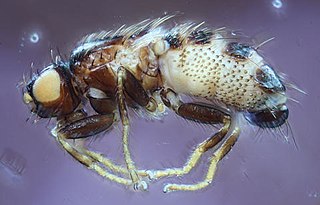
Carnus hemapterus is a Dipteran insect, a small-bodied and partly black-coloured carnid fly. In their adult stage of life, they are blood-sucking ectoparasites of nestling birds. Within the genus Carnus, this is the only species widespread across Europe and the cold and temperate regions of Asia and North America. Female body length is about 1.5 mm, males are smaller. It typically occurs in the nests of medium- to large-bodied birds, provided that the nest is not on the ground. It is particularly common on the chicks of owls, falcons, rollers, bee-eaters and starlings. Females give birth to larvae that live within the nest and feed on organic debris and the pupae also overwinter there. The emergence of imagines is synchronized to the hatch of host nestlings in the subsequent year. They prefer larger chicks within the nest. Adult flies have a winged and an unwinged variety, the latter being more common. In fact, unwinged flies still carry the basal part of their wings, but the majority of the wing is broken off. Flies live only on the nestlings before and during the development of the plumage, and disappear later on.
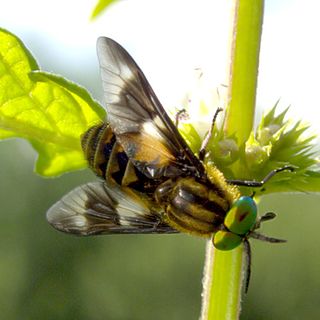
Superfamily Tabanoidea are insects in the order Diptera.

Minthoini is a tribe of flies in the family Tachinidae.

Carnus is a genus of flies (Diptera) with 5 described species, all of which are parasites of birds. The adult flies locate a suitable host nest, then shed their wings and feed on the blood of the developing nestlings. Mature female flies lay their eggs in the nest, where their larvae develop on organic detritus.
Hemeromyia is a genus of flies (Diptera).
Meoneura is a genus of carnid flies (Diptera).

Tethina is a genus of beach flies in the family Canacidae. They are found in all terrestrial biogeographic realms.
Sphaerocerinae is a subfamily of flies belonging to the family Sphaeroceridae.
Ischiolepta is a genus of flies belonging to the family lesser dung flies.

Limosininae is a subfamily of flies belonging to the family Sphaeroceridae, the lesser dung flies.
Archicollinella is a genus of flies belonging to the family Lesser Dung flies.
Chaetopodella is a genus of flies belonging to the family Sphaeroceridae, the lesser dung flies.
Chaetopodella is a subgenus of flies belonging to the family Sphaeroceridae, the lesser dung flies.
Lepidosina is a genus of flies belonging to the family lesser dung flies.
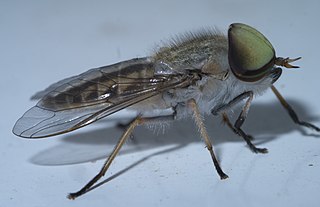
Tabaninae is a subfamily in the family Tabanidae commonly known as horse flies. There are more than 3000 described species in Tabaninae.










